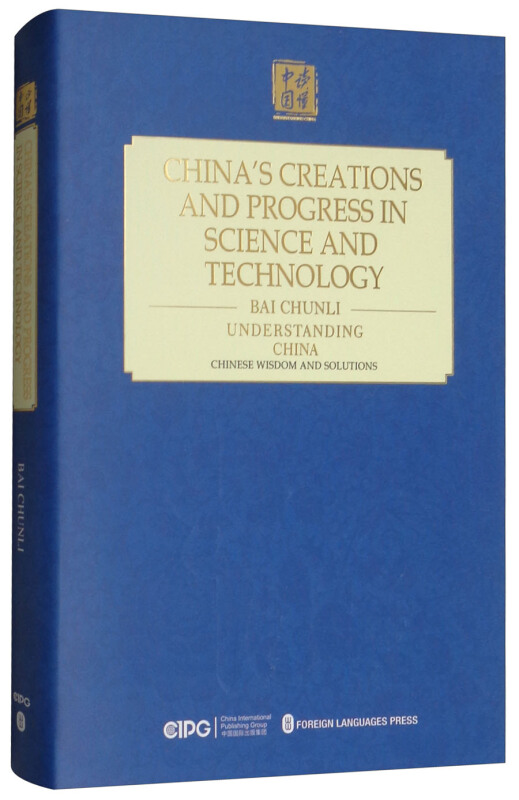
Chinas creations and progress in science and technology

- ISBN:9787119114910
- 装帧:一般胶版纸
- 册数:暂无
- 重量:暂无
- 开本:25cm
- 页数:375页
- 出版时间:2018-05-01
- 条形码:9787119114910 ; 978-7-119-11491-0
本书特色
这本书系统阐述中国科学技术从古代兴盛,经历近代落伍,到当代走向复兴的宏大历程。作者以典型案例展现中国古代做出的重大发明创造,介绍近代中国怎样受到世界科技革命浪潮的影响,勾画出新中国自20世纪50年代以来向科学进军、以科技为*生产力、实施创新驱动发展战略的壮阔图景,解读了国家现代化建设中的科技进步与创新,前瞻新时代的科技创新大势。这本书是从科技的传统和变革的独特视角,解读中国的发展及民族伟大复兴的一部佳作。
内容简介
《中国科技的创造与进步(英文)》系统阐述了在世界科技革命背景下,近现代中国科技的衰落与振兴,作者用客观的手笔刻画出当代中国向科技进军的壮阔图景,展现我们如何以科技进步与创新,助力中华民族伟大复兴事业。 《中国科技的创造与进步(英文)》同时也对国家发展科技的战略部署,以及中国科技的未来发展,进行了适当的解读。 《中国科技的创造与进步(英文)》可以称之为对外解读中国科技发展详实的一部著作。
目录
Chapter 1 China's Creations
Section 1 Sophisticated and Ingenious Farming and Weaving Techniques
Section 2 Exploitation of the Works of Nature
Section 3 Architectural Constructions in China
Section 4 Investigating Things to Exhaust Heavenly Principles
Section 5 Traditional Chinese Medicine and Pharmacy
Chapter 2 Spreading of Western Learning to the East
Section 1 Smelting Materials of Alien Source
Section 2 Learning the Strengths of Alien People
Section 3 Laying the Foundation of Modern Science in China
Chapter 3 Marching Toward Science
Section 1 Building a Modern Scientific and Technological System
Section 2 Planning on Science and Technology
Section 3 Technological Progess and Industrialization
Chapter 4 Reform and Innovation of the Scientific and Technological System
Section 1 Spring of Science
Section 2 Reform of the Scientific and Technological System
Section 3 Technology Introduction and Innovation
Section 4 Exploring the Unknown
Chapter 5 Innovation-Driven Development
Section 1 Innovative Development Concepts and Strategy
Section 2 From an Innovative Country to a World Power in Scientific and Technological Innovation
Section 3 Roadmap of Scientific and Technological Development in Important Areas by 2050
Section 4 New-Type Scientific Research System
Afterword
节选
《中国科技的创造与进步(英文)》: The traditional Chinese calendar is a lunisolar calendar, namely a calendar that takes the solar year as the basis of the length of a year and the synodic month as a month and adjusts the relation between seasons and months by setting leap months. In such a calendar, the correspondance between months and seasons has a certain range of disagreement, which can be nearly a month in maximum. In the beginning the 24 solar terms were determined in a year according to the position of the sun among the stars. This, in fact, is the part of solar calendar in traditional Chinese calendar. The 24 Solar Terms divide a tropical year into 24 equal intervals. Each term point is called a "JieQz" (pre-climate) or "ZhongQi" (mid-climate). Pre-climate and mid-climate are arranged in an alternating manner. Among them, pre-climates are State of Spring, Awakening of Insects, Clear and Bright, Start of Summar, Grain in Ear, Minor Heat, State of Autumn, White Dew, Cold Dew, State of Winter, Major Snow and Minor Cold; however, mid-climates include Rain Water, Spring Equinox, Grain Rain, Grain Buds, Summer Solstic, Major Heat, Limit of Heat, Autum Equinox, Frost Descent, Minor Snow, Winter Solstice and Major Cold. During the Southern and Northern Dynasties, astronomers discovered that the sun did not move evenly in the celestial background, so they modified the calculation of the 24 solar terms according to the actual position of the sun rather than simply divided a year's time into equal intervals. The 24 Solar Terms were mainly used to provide informauon for farming and became an integral part of tradiuonal Chinese culture. Many ancient Chinese poems take them as literary themes. Ancient Chinese astronomers divided the celestial sky into three enclosures or "Yuan" and 28 mansions or "X/u." The Chinese word Yuan means city walls. Three enclosures are in fact three celestial areas enclosed with "walls" carved out in the sky. The 28 mansions are 28 constellations. Such division method became mature in the Periods of Spring and Autumn and of Warring States. The 28 mansions and the North Celestial Pole were combined together to form an equtorial coordinate system in ancinet China. The position of any celestial body can be determined with "mansion-approaching degree" and "pole-departing degree." The 28 mansions were also grouped into four symbols, corresponding to four totems of the remote ancient Chinese peoples, respectively the Azure Dragon in the east, the White Tiger in the west, the Vermilion Bird in the south, and the Black Turtle in the north. For example, the Azure Dragon in the east includes seven mansions of Horn, Neck, Root, Room, Heart, Tail and Winnowing Basket. The term Three Enclosures appeared at the latest in the Sui (581-618) and Tang dynasties. These three enclosures were respectively Purple Forbidden, Supreme Palace and Heavenly Market. Due to the influence of the idea of the "unity between heaven and man," the arrangement and nomination of the celestial bodies in the sky corresponded with the human WOfld. For example, the enclosure of Purple Forbidden was a celestial area with the North CelesUal Pole as its center. It was regarded as the "imperial palace" in the heaven. In this enclosure, the "Emperor Star" corresponded to the emperor in the human world, "Empress Palace" to the empress in the human world and "Eight Grains" to the granary in the human world. The enclosure of the Supreme Palace was where the heavenly emperor and his ministers handled adminstrative matters. ……
作者简介
白春礼,1953年9月生,辽宁人。博士、化学家和纳米科技专家。现任中国科学院院长、党组书记、学部主席团执行主席,发展中国家科学院院长。同时担任中国科学院、发展中国家科学院、美国国家科学院、英国皇家学会、俄罗斯科学院等10余个国家科学院或工程院的院士。
-

毛泽东选集(全四册)
¥63.4¥97.5 -

为什么是中国(九品)
¥29.0¥58.0 -

毛泽东选集(普及本)(全四册)
¥52.8¥81.0 -

走向海洋(八品)
¥16.2¥59.8 -

马克思主义:赞成与反对
¥9.5¥35.0 -

论共产党员的修养
¥2.3¥5.5 -

兄弟连-纪念版
¥13.3¥38.0 -

走向海洋
¥16.1¥59.8 -

秘密访问-中美关系破冰亲历
¥14.8¥28.0 -

中国的婚姻与家庭
¥15.1¥39.8 -

毛泽东选集-(第三卷)
¥14.6¥18.0 -

浴血荣光
¥16.2¥45.0 -

(平装)二战战史
¥11.7¥45.0 -

步兵攻击:隆美尔手绘插图珍藏本
¥13.5¥45.0 -

1793乾隆英使觐见记(九品)
¥15.2¥39.0 -

国之脊梁:中国科学家的家国天下
¥37.7¥59.8 -

为什么是中国
¥29.0¥58.0 -

中国抗日战争史简明读本
¥12.3¥30.0 -

共产国际与广州国民政府关系史
¥16.8¥56.0 -

毛泽东自述(增订本)
¥45.2¥58.0











